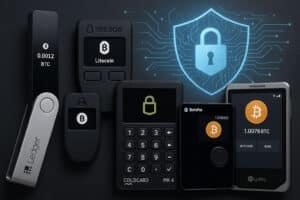
Cryptocurrency ownership comes with both great opportunities and significant risks. While blockchain technology is secure by design, crypto investors are often targeted by hackers due to poor personal security practices. By following the right steps, you can dramatically reduce your chances of falling victim to theft and safeguard your hard-earned digital assets.
Here are the seven best practices every crypto investor should follow to stay safe in today’s volatile digital world.
1. Use Hardware Wallets for Long-Term Storage
One of the most effective ways to secure your crypto is by using hardware wallets. Unlike hot wallets connected to the internet, hardware wallets keep your private keys offline, making it nearly impossible for hackers to access them remotely. Check out our guide to the Best rated hardware wallets to pick the right one for your needs.
| Wallet | Security Rating | Ease of Use | Price |
|---|---|---|---|
| Ledger Nano X | ★★★★★ | ★★★★☆ | $149 |
| Trezor Model T | ★★★★★ | ★★★★☆ | $219 |
| SafePal S1 | ★★★★☆ | ★★★☆☆ | $50 |
2. Enable Two-Factor Authentication (2FA)
Never rely solely on a password. Enabling 2FA adds a second layer of security, usually via an authenticator app, making it much harder for hackers to access your exchange accounts.
3. Beware of Phishing Scams
Hackers often impersonate exchanges, wallets, or influencers to trick investors into giving away their keys. Always double-check URLs, never click suspicious links, and verify official sources.
4. Diversify Storage Methods
Don’t keep all your crypto in one place. Spread assets across hardware wallets, cold storage, and trusted exchanges to minimize risk exposure.
5. Keep Software and Devices Updated
Outdated systems are easy targets. Regularly update your wallet apps, antivirus, and device firmware to patch vulnerabilities before attackers exploit them.
6. Use Strong, Unique Passwords
A strong password should be at least 12–16 characters long with numbers, symbols, and upper/lowercase letters. Consider using a password manager to generate and securely store them.
7. Limit Exchange Exposure
Exchanges are prime targets for hacks. Withdraw funds to secure wallets after trading instead of leaving them on centralized platforms.
Pros and Cons of Common Security Measures
| Security Measure | Pros | Cons |
|---|---|---|
| Hardware Wallets | Maximum security, offline storage | Upfront cost, requires setup |
| 2FA | Easy to set up, adds strong layer of security | Can be inconvenient, phone dependency |
| Cold Storage | Unhackable when offline | Less convenient for frequent traders |
Overall Security Ratings
We’ve rated the most common crypto security practices based on effectiveness, ease of implementation, and long-term reliability:
- Hardware Wallets: ★★★★★
- 2FA Authentication: ★★★★☆
- Cold Storage: ★★★★☆
- Exchange Storage: ★★☆☆☆
Final Thoughts
Crypto investors face unique risks, but most hacks happen due to weak personal security practices rather than flaws in blockchain technology. By combining hardware wallets, strong passwords, 2FA, and vigilance against phishing, you can keep your digital assets secure. Remember: once your crypto is stolen, it’s almost impossible to recover—so prevention is everything.
